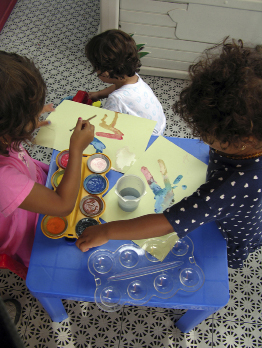Inquiry 3
| Site: | MoodleHUB.ca 🍁 |
| Course: | Early Learning and Child Care 30 Modules |
| Book: | Inquiry 3 |
| Printed by: | Guest user |
| Date: | Thursday, 18 December 2025, 10:32 AM |
Description
Created by IMSreader
1. Inquiry 3
Session 3: Observing Young Children
Inquiry 3: Characteristics of a Quality Observation

© lozanona/iStockphoto
One of the requirements of a quality observation is that the child care provider be objective. It is important to be as impartial as possible and to stand back and record what is actually happening and not what you think the child is experiencing. Consider the following examples:
- Quality Record of Observable Behaviour: M. (age five years) entered the room taking small steps, and then jumped into the chair at the front of the table. She looked up at me. With a large grin on her face she said, “I really like you guys!”
- Poor Record of Observable Behaviour: M. (age five years) entered the room as though she were shy. She rushed to the chair and stated that this was the best room!
Observing children’s body language and the inflection of the child’s voice is very important. Children tell a lot about behaviour by how softly or loudly they speak and by whether or not their facial and body reactions are large or small. Because young children lack verbal communication skills, child care providers must rely on sounds and facial expressions, such as the child’s crying or smiling.
inflection: a change in the pitch or tone of the voice
1.1. Learning Activity 3
Session 3: Observing Young Children
Learning Activity 3: Appropriate Observations
Focus
The role of an observer is to record the experiences of the children in detail. It is important for the child care provider to be as impartial as possible and to record what is seen, rather than to assume what the child is thinking or feeling.
Directions
Step 1: Read Observation 1 and Observation 2.
Important: The children’s first initials are used in the following observations. The child care provider is referred to as “the” or “a” child care provider. Writing observations in this way ensures the confidentiality of the children, families, and child care providers.
Step 2: After reading Observation 1 and Observation 2, Complete Part 1 of Learning Activity 3: Appropriate Observations.
Important: Prior to your making or writing observations about children in the child care facility, you must have written permission from the child’s parent or guardian. Obtain a copy of the Consent Form for Student Research from your teacher.
Step 3: Go to an acceptable child care facility and observe the activities and interactions of one child. Choose the most appropriate observation technique or use a combination of techniques.
Step 4: Complete Part 2 of Learning Activity 3: Appropriate Observations.
Checking In
Save your completed learning activity in the appropriate sub-folder of your course folder.